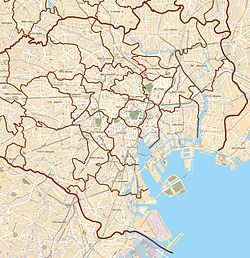Fukagawa (Tokyo)
|
Fukagawa 深川 |
|
|---|---|
| District | |

Fukagawa in the evening
|
|
| Location in Tokyo | |
| Coordinates: 35°40′33″N 139°47′46″E / 35.67583°N 139.79611°E | |
| Country | Japan |
| Prefecture | Tokyo |
| Area | |
| • Total | 0.22 km2 (0.08 sq mi) |
| Population (August 2015) | |
| • Total | 3,843 |
| Postal Code | 135-0033 |
Fukagawa (深川?) is a region in Kōtō, Japan. It is one of the representative shitamachi of Tokyo. Formerly, it was a ward of the historical Tokyo City.
Fukagawa is named after its founder, Fukagawa Hachirozaemon. Originally, parts of Fukagawa below the Eitai river (excluding Etchujima) was sea; Hachirozaemon developed these areas with landfills.
After losing about 60 percent of the city in the Great Fire of Meireki of 1657, the shogunate ordered for Buddhist temples on the east bank of the Sumida river, and on both the north and west banks of the Onagi River, to be relocated. At the time, this area was occupied mainly by fishermen, with a population of just over a thousand. In 1695, it officially became the town "Fukagawa-Sagamachi."
Sagamachi was a place full of granaries storing rice and grains. The large quantity of these granaries lead to Sagamachi developing into a center for grains trade. Up until World War II, it was known to some as Tokyo's largest grain market. Later, the construction of bridges along the Sumida River (which had been previously prohibited for security purposes) allowed greater access to the area. Sagamachi became a gateway for the neighboring towns of Monzen-machi, and a red-light district developed.
In 1947, Fukagawa was incorporated into the ward of Koto, together with Suginami.
Fukagawa is known for its relations to the famous Japanese poet, Matsuo Bashō. In 1680, Basho moved to Fukagawa. Here, he wrote one of his most famous poems, .
Coordinates: 35°40′37″N 139°47′49″E / 35.67694°N 139.79694°E
...
Wikipedia

